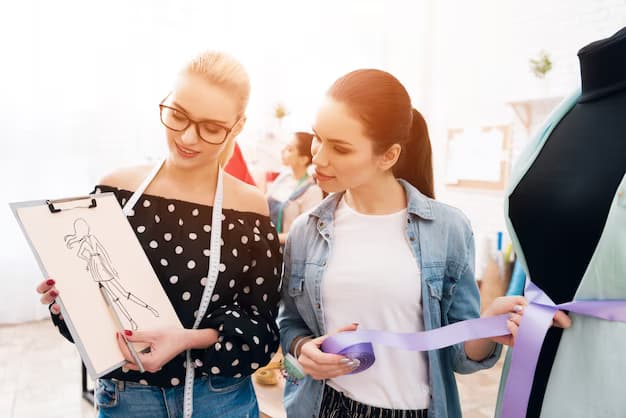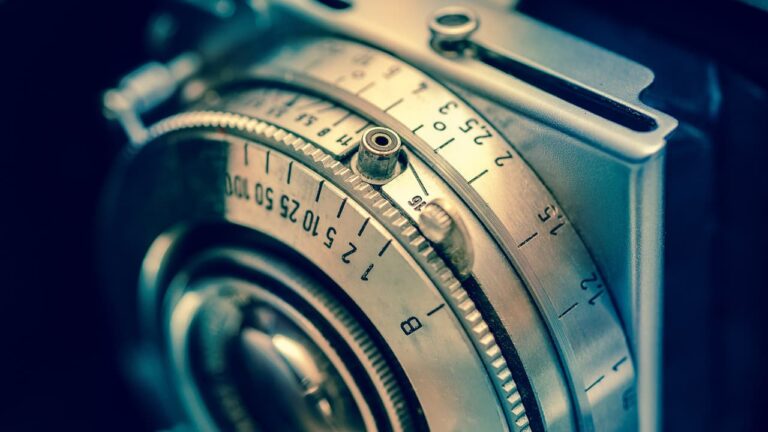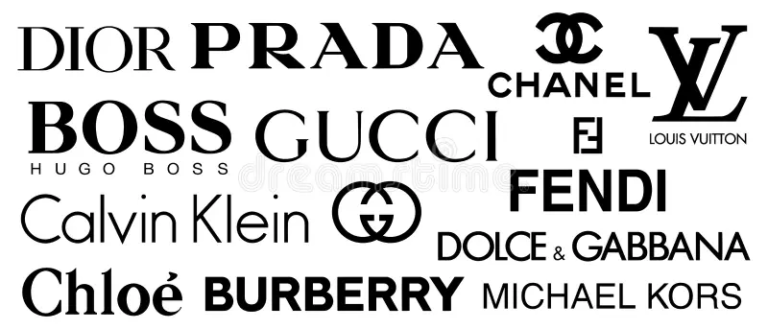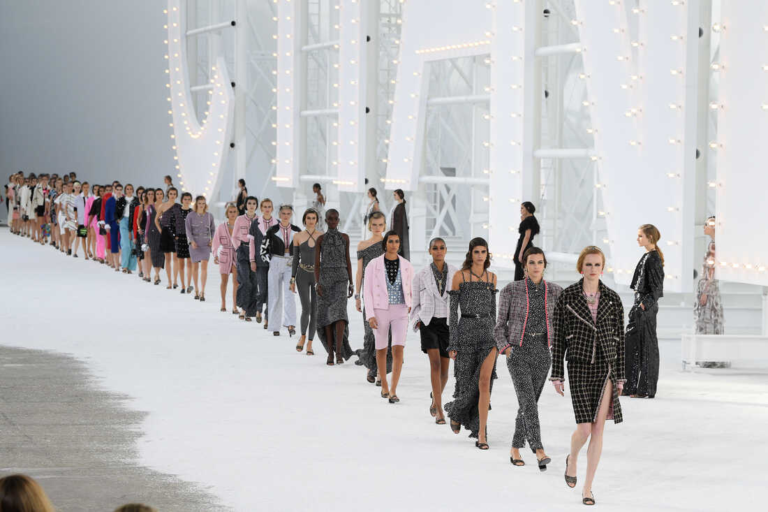Fashion, much like language, is an ever-evolving entity. To truly appreciate its nuances, it’s essential to understand its vocabulary. From haute couture to prêt-à-porter, today we’re diving deep into 30 fashion terms that every style enthusiast should know.
1. Haute Couture
Haute Couture, a term synonymous with luxury and exclusivity, originates from Paris, the heart of fashion. When you think of Haute Couture, picture designers meticulously crafting garments, ensuring each stitch and drape is perfect. Unlike off-the-rack clothing, Haute Couture pieces are tailored to an individual’s body, ensuring a perfect fit every time. It’s like having a symphony in fabric form, where each note represents a carefully chosen bead or sequin.
Key Characteristics:
- Exclusive custom-fitted design
- High-quality fabric and materials
- Hand-sewn with attention to detail
2. Prêt-à-Porter
Opposite to the realm of Haute Couture, Prêt-à-Porter (Ready-to-Wear) offers fashion enthusiasts access to designer creations without the waiting time or high price tags. These pieces, though produced in larger quantities, still maintain a touch of luxury. The beauty of Prêt-à-Porter lies in its accessibility and the blend of style with convenience.
Example Brands:
- Zara
- Topshop
- Chanel’s Ready-to-Wear collection
3. A-line
An A-line garment, named due to its resemblance to the letter ‘A’, is a universally flattering silhouette. Often found in dresses and skirts, this design nips in at the waist and flares out towards the hem, creating an illusion of an hourglass figure. It’s a favorite among many due to its versatility and ability to suit various body types.
Popular A-line Items:
- Bridal gowns
- Summer dresses
- Midi skirts
4. Avant-garde
Pushing the boundaries of conventional design, Avant-garde fashion is all about innovation. Think of outfits you’d see in high-fashion runway shows, where designers combine art with fashion, resulting in wearable masterpieces.
Famous Avant-garde Designers:
- Rei Kawakubo of Comme des Garçons
- Yohji Yamamoto
- Maison Margiela
5. Bespoke
Often used in the realm of suiting, the term ‘bespoke’ represents the pinnacle of customization. Every detail, from the fabric type to the placement of pockets, is dictated by the individual. It’s not just about fit; it’s about crafting a piece that encapsulates an individual’s essence.
Bespoke Vs. Haute Couture:
| Bespoke | Haute Couture |
|---|---|
| Typically refers to suits | Exclusive designer gowns |
| Customized for an individual | Made for individual fit |
| Less emphasis on art | Balance of art and wearability |
6. Capsule Wardrobe
The concept of a capsule wardrobe encourages individuals to streamline their closet, retaining only versatile and essential items. This approach not only simplifies decision-making but also promotes sustainable consumer habits.
Capsule Wardrobe Basics:
- A classic white tee
- Dark-wash jeans
- A tailored blazer
- Neutral flats
- A little black dress
7. Draping
Draping, often seen as an art form in the fashion industry, is the method by which fabric is manipulated directly on a dress form or mannequin. This technique allows designers to visualize and adjust the flow, fit, and structure of a garment in real-time. It’s akin to sculpting but with textiles. Designers like Madame Grès and Jean Paul Gaultier have used draping to great effect in their iconic creations.
Draping Vs. Flat Pattern:
| Draping | Flat Pattern |
|---|---|
| Direct manipulation on form | Paper patterns used |
| Intuitive & organic | Precise & geometric |
| Ideal for fluid designs | Ideal for structured pieces |
8. Fast Fashion
A double-edged sword in the world of style, fast fashion represents the rapid production and distribution of current fashion trends at accessible prices. While it allows consumers to access the latest styles swiftly, it often comes under scrutiny for environmental and ethical concerns.
Pros and Cons of Fast Fashion:
- Pros: Affordable, Trend-driven, Accessible
- Cons: Environmental concerns, Ethical issues, Quality can be compromised
9. Lookbook
A lookbook, often the first touchpoint between designers and their audience for a new collection, is a compilation of photographs that showcase a brand’s upcoming offerings. While traditionally printed, many brands now release digital lookbooks, leveraging platforms like Instagram for a wider reach.
Purpose of a Lookbook:
- Introduce new collections
- Engage potential buyers
- Set the tone and narrative for a brand’s season
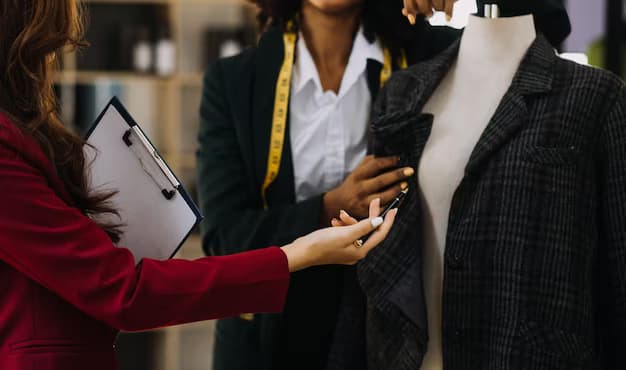
10. Silhouette
In fashion terms, a silhouette is the basic outline or shape of a garment. It’s the first thing one might notice from a distance, even before the color or pattern. From the voluminous ball gowns of the 1850s to the sleek sheath dresses of the 1960s, the silhouette can define an era.
Popular Silhouettes:
- A-line: Flares gently from the waist
- Sheath: Straight-cut, close-fitting
- Mermaid: Fitted till the knee, flares at the bottom
11. Boxy Fit
Boxy fit clothing doesn’t hug the contours of the body but presents a more square or rectangular shape. They often appear slightly oversized and provide a relaxed look. This design provides a modern, comfortable fit and is a favorite in contemporary urban fashion.
Benefits of Boxy Fit:
- Comfort: Provides ample room for movement.
- Versatility: Can be dressed up or down depending on the occasion.
- Universal Appeal: Flattering for various body types, as it doesn’t emphasize specific body features.
12. Vintage
The term vintage, often synonymous with timeless charm, refers to clothing from a previous era, generally two decades ago or more. It’s not just about age; it’s about quality and the historical context of the item.
Vintage vs. Retro:
| Vintage | Retro |
|---|---|
| Authentic pieces from past eras | Modern pieces styled after an era |
| Has historic value | Inspired by history but lacks historic value |
13. Statement Piece
A statement piece is that magic item that can uplift an entire ensemble. It’s loud, proud, and commands attention. Whether it’s a bold necklace, a bright handbag, or uniquely designed shoes, this piece often reflects the wearer’s personality.
Examples of Statement Pieces:
- Chunky jewelry
- Bold scarves
- Designer handbags
- Unique footwear
14. Peplum
The peplum design offers a ruffle or short flared fabric attached to the waist of a blouse, jacket, or skirt. Originally popularized in the 1940s, it has seen a resurgence in contemporary fashion for its flattering effect, adding curves and dimension.
Why Peplum Stands Out:
- Flattering Shape: Enhances the waist and gives an illusion of an hourglass figure.
- Versatility: Can be incorporated in both formal and casual attire.
15. Monochrome
Monochrome fashion is about creating an outfit using just one color or varying shades of a single hue. It exudes simplicity, sophistication, and confidence.
Tips for Monochrome Dressing:
- Layer with Different Textures: Adds depth to the look.
- Accessorize Wisely: Use neutral or complementary colors.
- Play with Patterns: Ensure they’re in the same color family.
16. Accessory
An accessory in fashion serves to complete or enhance outfits. While they might seem secondary, the right accessory can make or break a look. From scarves and jewelry to hats and belts, accessories offer a chance to showcase individual style.
Three Must-have Accessories:
- Statement Necklace: Perfect for elevating a simple outfit.
- Classic Watch: Merges functionality with style.
- Versatile Scarf: Can be styled in multiple ways, suitable for all seasons.
17. Androgynous
Androgynous fashion blurs the lines between traditionally male and female clothing. This style allows wearers to explore a broader spectrum of fashion without being boxed into gender norms.
Iconic Figures in Androgynous Fashion:
- David Bowie
- Grace Jones
- Tilda Swinton
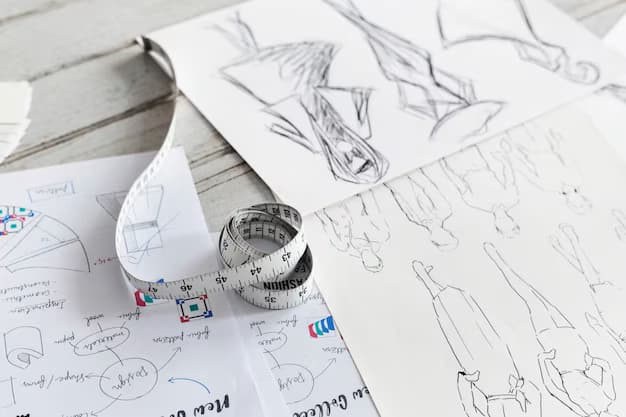
18. Bias Cut
A bias cut means the fabric has been cut diagonally across the grain, allowing it to gracefully drape and mold to the body. This technique, popularized in the 1930s, is often used in dresses and skirts for a figure-hugging silhouette.
Advantages of Bias Cut:
- Enhanced Fit: The diagonal cut allows the fabric to stretch over curves.
- Fluidity: Gives the garment a natural, flowing movement.
- Elegance: Offers a graceful, timeless look.
19. Color Blocking
Color blocking is a technique that combines two or more bold colors in a single outfit. It’s a way to make a fashion-forward statement by pairing contrasting, yet complementary hues. Think of a royal blue skirt matched with a bright yellow top.
How to Master Color Blocking:
- Stick to Solids: Avoid patterns to maintain the focus on bold colors.
- Use Neutral Accessories: Keep accessories neutral to not overwhelm the look.
- Balance is Key: If one piece is ultra-bright, balance it with a more subdued color.
20. Empire Waist
The empire waist design features a raised waistline that sits just below the bust, from which the rest of the dress flows down. This silhouette elongates the body and is especially flattering for those wanting to emphasize their bust.
Empire Waist Benefits:
- Accentuates the Bust: Draws attention upwards.
- Camouflages the Midsection: Perfect for those who prefer a looser fit around the belly.
- Versatility: Works for both casual and formal outfits.
21. Ethical Fashion
Ethical fashion is a movement that emphasizes moral principles in the production of clothing. It concerns itself with the working conditions of laborers, the environment, and cruelty-free methods.
Ethical Fashion vs. Fast Fashion:
| Ethical Fashion | Fast Fashion |
|---|---|
| Prioritizes sustainability | Mass production at lowest cost |
| Fair wages and working conditions | Often exploits labor |
| Timeless pieces | Quick, transient trends |
22. Juxtaposition
In fashion, juxtaposition involves pairing contrasting items together to create a unique style. Imagine a rugged leather jacket worn over a delicate lace dress.
Examples of Juxtaposition in Fashion:
- Textures: Silky vs. rugged.
- Styles: Vintage with modern.
- Colors: Bright with muted.
23. Minimalism
Minimalistic fashion is the embodiment of the “less is more” philosophy. It focuses on simple designs, clean lines, and a restricted color palette. The goal is to create timeless pieces that outlast transient fashion trends.
Keys to Minimalist Fashion:
- Neutral Colors: Stick to blacks, whites, grays, and beiges.
- Functionality: Each piece should serve a purpose.
- Quality over Quantity: Invest in high-quality staples rather than numerous low-quality items.
24. Patchwork
Patchwork is a design technique that involves sewing together pieces of fabric to create a larger, cohesive design. This style can be both rustic, reminiscent of handmade quilts, or avant-garde, presenting unexpected fabric combinations.
Patchwork Popularity Reasons:
- Eco-friendly: A great way to repurpose fabric scraps.
- Unique Look: No two patchwork items are identical.
- Historical Significance: Evokes memories of quilts passed down through generations.
25. Ruching
Ruching is a sewing technique where fabric is gathered to create a rippled effect. This can add both texture and shape to a garment. You often see ruching in dresses, adding detail to the bust or side seams.
Benefits of Ruching:
- Versatile Detailing: Adds interest without overwhelming the design.
- Flattering: Can camouflage areas and enhance the garment’s overall fit.
- Dynamic Texture: Adds a tactile element to the clothing piece.
26. Tailoring
Tailoring is the age-old art of crafting garments to fit an individual perfectly. It’s about precision, ensuring every stitch, seam, and hem enhances the wearer’s figure. The realm of tailoring is vast, from creating bespoke suits to altering off-the-rack clothes for an impeccable fit.
Why Invest in Tailoring:
- Perfect Fit: Garments are adjusted to the wearer’s unique measurements.
- Enhanced Comfort: Tailored pieces tend to be more comfortable due to the precise fit.
- Timeless Pieces: Well-tailored items often outlast trends, becoming wardrobe staples.
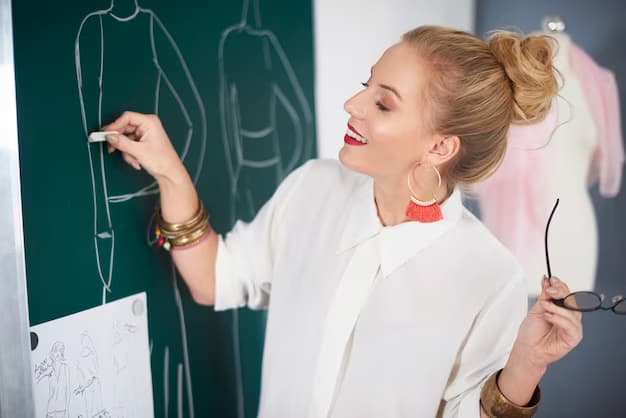
27. Texture
Texture in fashion refers to the feel and appearance of a garment’s surface. It’s an element that can transform a simple garment into something intriguing and tactile. From the softness of velvet to the roughness of corduroy, texture adds depth and dimension.
Textures to Explore:
- Velvet: Luxurious and soft to the touch.
- Denim: Sturdy with a distinctive weave.
- Lace: Delicate and ornate, adding femininity.
- Tweed: Thick and woolly, perfect for colder seasons.
28. Trench Coat
The trench coat, with its distinctive double-breasted design, epaulets, and belt, is a classic piece of outerwear. Initially designed for military use during World War I, it’s now a staple in fashion wardrobes, synonymous with style and sophistication.
Features of a Trench Coat:
- Weatherproof: Typically made from durable, water-resistant materials.
- Versatile: Can be dressed up or down, suitable for various occasions.
- Timeless Appeal: Its design has remained largely unchanged, proving its enduring style.
29. Unisex
Unisex fashion breaks away from gender norms, offering clothing designs suitable for all genders. It’s about versatility, inclusivity, and challenging traditional fashion boundaries.
Benefits of Unisex Fashion:
- Inclusivity: Everyone, regardless of gender, can wear the garment.
- Versatility: Often designed with a relaxed fit, suitable for various body types.
- Sustainability: Shareable among different genders, promoting longer garment lifespans.
30. Yoke
In fashion, a yoke is a panel, usually fitted, that provides structure to the area where it’s applied, be it the shoulders, waist, or other parts of a garment. It’s often used in western shirts, dresses, and skirts to enhance fit and add decorative flair.
Importance of Yoke in Design:
- Improved Fit: Provides a structured fit, especially in the shoulder area.
- Decorative Element: Often embellished or designed with contrasting fabric to stand out.
- Support: Distributes the garment’s weight, ensuring comfort and longevity.
Conclusion
Fashion, much like language, is continuously evolving, adding new terms and ideas to its vast lexicon. Whether you’re a fashion enthusiast or a novice, understanding these terms not only helps in making informed wardrobe choices but also deepens the appreciation for the art and craft behind every garment.
FAQs
Haute couture is custom-made, while prêt-à-porter is ready-to-wear and mass-produced.
Consumers are becoming more conscious of the environmental and ethical implications of their purchases, driving demand for sustainable and ethically produced fashion.
Texture adds depth, contrast, and tactile elements to garments, enhancing their aesthetic appeal and feel.
Not necessarily. While both challenge traditional gender norms, unisex designs are made for all genders, while androgynous styles blend masculine and feminine elements.
A yoke provides structure, especially to the shoulders or waist, and can also serve as a decorative element.
